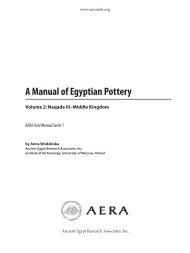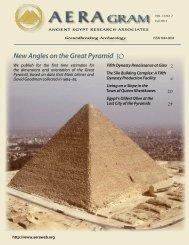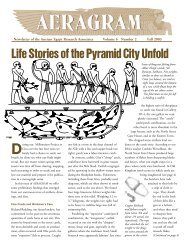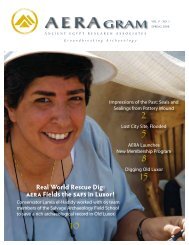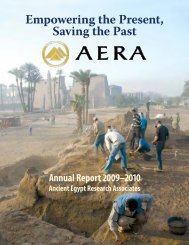The Khentkawes Town (KKT) - Ancient Egypt Research Associates
The Khentkawes Town (KKT) - Ancient Egypt Research Associates
The Khentkawes Town (KKT) - Ancient Egypt Research Associates
You also want an ePaper? Increase the reach of your titles
YUMPU automatically turns print PDFs into web optimized ePapers that Google loves.
www.aeraweb.org<br />
Burial 456 (Square 101.V30, Cut [29,960], Fill [29,961], Skeleton [29,968]),<br />
Color Plate 4.2<br />
This burial was a shallow grave located on the edge of the Selim Hassan trench in<br />
Area <strong>KKT</strong>-F. It had been truncated by a robber’s cut [29,962] which truncated the<br />
lower leg bones of the body and disturbed the grave. It may also have been truncated<br />
from above, most likely during the Selim Hassan excavations. It was an adult burial,<br />
most likely female, judging from the mastoid process fragments. <strong>The</strong> bones were<br />
very fragmented and the only easily identifiable pieces belonged to the humerus.<br />
Some of the other pieces may belong to other long bones as well and will be studied<br />
further in the storeroom. No pathologies were noted and no teeth were recovered.<br />
In the robber’s cut [29,962], secondary bones were found and those were designated<br />
as skeleton [29,965] in fill [29,963]. <strong>The</strong> fragmented pieces were from the left fibula<br />
and tibia, and since there were no duplicates, they most likely originally belonged to<br />
skeleton [29,968], but had been re-deposited.<br />
Figure 48. Burial 456,<br />
Skeleton [29,968].<br />
Burial 457 (Square 101.V–W27–28, Cut [30,121],<br />
Fill [30,122], [30,123], [30,205]), Color Plate 5.1<br />
This was a primary double burial, containing an older<br />
male [30,211] and a female [30,210]. <strong>The</strong> female skeleton<br />
was lying partially on her right side, loosely flexed,<br />
with her head on the thorax area of the male who was<br />
lying extended on his back. <strong>The</strong>re was no indication of<br />
disturbance in the burial fills, so the two individuals<br />
appear to have been interred together. Further,<br />
judging from the burial positions, they were not<br />
tightly wrapped at the time of burial. <strong>The</strong> burial was<br />
covered by a pottery-rich deposit [30,122], overlying<br />
large limestone boulders [30,123] that weighed 412 kg<br />
with one worked stone that weighed 35 kg. A limestone<br />
grinding stone was also recovered from the limestone<br />
feature. Underneath the limestone layer was a yellow<br />
sand fill, [30,205]. Also, one tubular faïence bead was<br />
recovered from the fill of Burial 457.<br />
Figure 49. Burial 457, Skeletons [30,210] and [30,211].<br />
Giza Occasional Papers 4 57





